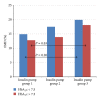Insulin therapy with personal insulin pumps and early angiopathy in children with type 1 diabetes mellitus
- PMID: 24347835
- PMCID: PMC3848272
- DOI: 10.1155/2013/791283
Insulin therapy with personal insulin pumps and early angiopathy in children with type 1 diabetes mellitus
Abstract
Objective: Assessment of the effect of a treatment method change from multiple daily insulin injection (MDI) to continuous subcutaneous insulin infusion (CSII) on the development of early angiopathy in children with T1DM with or without retinopathy.
Methods: The study pump group involved 32 diabetic children aged 14.8, with the initial HbA1c level of 8.3%, previously treated by MDI. The patients were examined before pump insertion and after 3 and 6 months of CSII. We assessed HbA1c level, carotid artery intima-media thickness (c-IMT), and flow-mediated dilatation (FMD) of the brachial artery. The pump group was compared to a group of eight teenagers with diagnosed nonproliferative retinopathy, treated with MDI.
Results: HbA1c in the entire group was found to improve in the second and in the third examination. During 6 months of CSII, FMD increased and IMT decreased. Retinopathic adolescents had significantly thicker IMT and lower FMD compared to baseline results of the pump group. Treatment intensification in the retinopathy-free children enhanced these differences.
Conclusions: CSII is associated with lower IMT and higher FMD. Whether on the long-run CSII is superior to MDI to delay the occurrence of diabetes late complications remains to be explained.
Figures






Similar articles
-
Vascular and Myocardial Function in Young People with Type 1 Diabetes Mellitus: Insulin Pump Therapy Versus Multiple Daily Injections Insulin Regimen.Exp Clin Endocrinol Diabetes. 2022 Jun;130(6):415-422. doi: 10.1055/a-1523-7574. Epub 2021 Aug 12. Exp Clin Endocrinol Diabetes. 2022. PMID: 34384121
-
Continuous subcutaneous insulin infusion therapy is associated with reduced retinopathy progression compared with multiple daily injections of insulin.Diabetologia. 2021 Aug;64(8):1725-1736. doi: 10.1007/s00125-021-05456-w. Epub 2021 May 8. Diabetologia. 2021. PMID: 33966091 Free PMC article.
-
Does treatment with an insulin pump improve glycaemic control in children and adolescents with type 1 diabetes? A retrospective case-control study.Pediatr Diabetes. 2015 Nov;16(7):546-53. doi: 10.1111/pedi.12209. Epub 2014 Oct 20. Pediatr Diabetes. 2015. PMID: 25327782
-
Management of diabetes mellitus: is the pump mightier than the pen?Nat Rev Endocrinol. 2012 Feb 28;8(7):425-33. doi: 10.1038/nrendo.2012.28. Nat Rev Endocrinol. 2012. PMID: 22371161 Review.
-
Continuous insulin infusion (CSII) or modern type of multiple daily injections (MDI) in diabetic children and adolescents a critical review on a controversial issue.Pediatr Endocrinol Rev. 2007 Dec;5(2):666-78. Pediatr Endocrinol Rev. 2007. PMID: 18084161 Review.
Cited by
-
Atherosclerosis: risk assessment and the role of aiming for optimal glycaemic control in young patients with type 1 diabetes.Pediatr Endocrinol Diabetes Metab. 2023;29(1):42-47. doi: 10.5114/pedm.2022.122546. Pediatr Endocrinol Diabetes Metab. 2023. PMID: 36734394 Free PMC article. Review.
-
Comparison of continuous subcutaneous insulin infusion treatment and multiple daily injection treatment on the progression of diabetic complications in Japanese patients with juvenile-onset type 1 diabetes mellitus.J Diabetes Investig. 2022 Sep;13(9):1528-1532. doi: 10.1111/jdi.13819. Epub 2022 May 19. J Diabetes Investig. 2022. PMID: 35474612 Free PMC article.
-
Cardiometabolic risk factors, peripheral arterial tonometry and metformin in adults with type 1 diabetes participating in the REducing with MetfOrmin Vascular Adverse Lesions trial.Diab Vasc Dis Res. 2023 May-Jun;20(3):14791641231183634. doi: 10.1177/14791641231183634. Diab Vasc Dis Res. 2023. PMID: 37387358 Free PMC article. Clinical Trial.
-
Narrative review of the role of technology in pediatric diabetes: from testing blood glucose to subcutaneous automated therapy and hope for cure.Transl Pediatr. 2023 Sep 18;12(9):1725-1734. doi: 10.21037/tp-23-145. Epub 2023 Sep 14. Transl Pediatr. 2023. PMID: 37814709 Free PMC article. Review.
-
Adherence to Carbohydrate Counting Improved Diet Quality of Adults with Type 1 Diabetes Mellitus during Social Distancing Due to COVID-19.Int J Environ Res Public Health. 2022 Aug 9;19(16):9776. doi: 10.3390/ijerph19169776. Int J Environ Res Public Health. 2022. PMID: 36011412 Free PMC article.
References
-
- Bruttomesso D, Costa S, Baritussio A. Continuous subcutaneous insulin infusion (CSII) 30 years later: still the best option for insulin therapy. Diabetes/Metabolism Research and Reviews. 2009;25(2):99–111. - PubMed
-
- Danne T, Battelino T, Jarosz-Chobot P, et al. Establishing glycaemic control with continuous subcutaneous insulin infusion in children and adolescents with type 1 diabetes: experience of the PedPump Study in 17 countries. Diabetologia. 2008;51(9):1594–1601. - PubMed
-
- Phillip M, Battelino T, Rodriguez H, Danne T, Kaufman F. Use of insulin pump therapy in the pediatric age-group: consensus statement from the European Society for Paediatric Endocrinology, the Lawson Wilkins Pediatric Endocrine Society, and the International Society for Pediatric and Adolescent Diabetes, endorsed by the American Diabetes Association and the European Association for the Study of Diabetes. Diabetes Care. 2007;30(6):1653–1662. - PubMed
-
- Jeitler K, Horvath K, Berghold A, et al. Continuous subcutaneous insulin infusion versus multiple daily insulin injections in patients with diabetes mellitus: systematic review and meta-analysis. Diabetologia. 2008;51(6):941–951. - PubMed
-
- Hammond P. Continuous subcutaneous insulin infusion: short-term benefits apparent, long-term benefits speculative. The British Journal of Diabetes and Vascular Disease. 2004;4(2):104–108.
MeSH terms
Substances
LinkOut - more resources
Full Text Sources
Other Literature Sources
Medical

